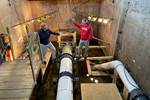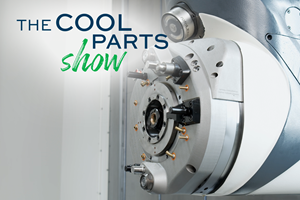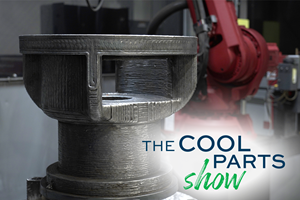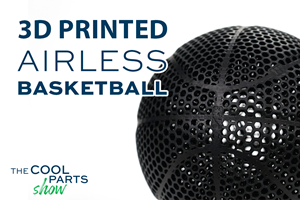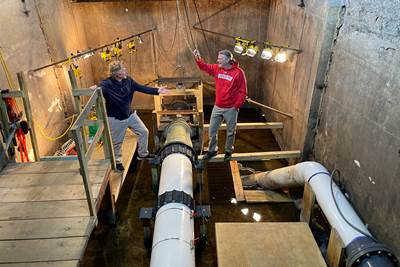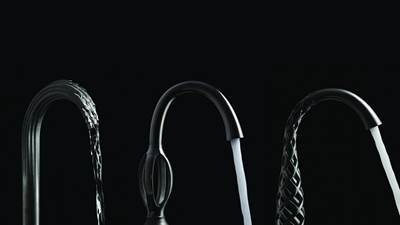Water or other fluids moving at a high flow rate through a control valve can be subject to cavitation able to damage pipes downstream. The solution was known decades ago: Divide the flow into an array of many much smaller parallel streams. Unfortunately, the geometry required to realize this effect resulted in a part that was difficult to produce — to the point that an early anti-cavitation product for ball valves was discontinued. Now, additive manufacturing has overcome this challenge. The Emerson company produces its Fisher Cavitrol Hex anti-cavitation trim in an essentially unattended process through laser powder bed fusion, and so far about 600 of these components have been installed in industrial ball valve applications. | This episode of The Cool Parts Show brought to you by Carpenter Additive
The Cool Parts Show is a video series from Additive Manufacturing Media that explores the what, how and why of unusual 3D printed parts. Watch more here.
Have a cool part to share? Email us.
Related Resources
- More on the Fisher Cavitrol Hex trim
- Intro to laser powder bed fusion
- 3D printing for hydropower components
- Fluid flow optimization in an air duct via 3D printing
- More on valves in Valve Magazine (also from Gardner Business Media)
Transcript
00:00:00:02 - 00:00:00:14
Peter Zelinski
I'm Pete.
00:00:01:01 - 00:00:13:06
Stephanie Hendrixson
I'm Stephanie. And this is The Cool Parts Show. Today on the show, we're going to be looking at this part that looks kind of like a honeycomb or a wasp nest. Actually, this part helps to maintain efficiency and pressure in industrial systems that move lots of fluid.
00:00:13:17 - 00:00:43:00
Peter Zelinski
That's right. So this component fits like this into this ball valve or a ball valve like this model. This is reduced scale compared to this part, but this component controls for pressure drops and protects against the potential effects those pressure drops can have downstream. Cavitation, on this episode of The Cool Parts Show.
00:00:52:07 - 00:01:12:05
Stephanie Hendrixson
This is our show all about cool, unique, unusual 3D printed parts. If you like what you see, help us out and hit that subscribe button. Today we're going to be talking about this valve component. This is the Fisher Cavitrol Hex Trim. So a lot to unpack there. Fisher, that is the brand name under Emerson, the manufacturer of this product. Cavitrol is the product name. The hex part comes from the shape of these tubes and this is a trim. It is part of a ball valve assembly. The purpose of this part is to control, to limit cavitation. So cavitation control, Cavitrol.
00:01:26:07 - 00:01:54:06
Peter Zelinski
So this component fits inside of a valve, a ball valve like this model. Emerson makes various sizes of this type of component this trim, including sizes much bigger than this one. They're all made through additive manufacturing and the function this trim plays has to do with what happens when water or another fluid flows through this valve at a very high rate.
The resulting pressure drops can create effects downstream, forces downstream that are potentially so violent in their effect on the piping downstream from this valve that in some industrial facilities they are accustomed to just routinely replacing part of their fluid handling systems because of the result of this effect. So let's understand the problem. What is cavitation? Here is Brandon Bell. He is the product marketing manager for Emerson for the Fisher Rotary Products brand, and he's coming from the Emerson Solutions Center in Marshalltown, Iowa.
00:02:38:18 - 00:03:03:20
Brandon Bell
So consider liquid flowing in a horizontal pipe and there is a restriction such as a control valve. As fluid flows through the restriction, it accelerates and there is an increase in velocity. Bernoulli's principle, which can be derived from the law of conservation of energy, states that in fluid dynamics, an increase in velocity results in a simultaneous decrease in pressure. If the pressure drops below the vapor pressure of the fluid, then vapor bubbles will form as liquid turns to gas. Now downstream of the restriction, the velocity slows, resulting in an increase in pressure. If the pressure recovers to a point higher than the fluid vapor pressure implosion of the vapor bubbles occurs as it returns to liquid form. A vapor bubble collapsing causes a liquid micro jet of fluid flow and a localized pressure wave. If this occurs near the internal surface of a pipe or control valve, the micro jet of fluid can impinge on the metallic surface causing damage. And if this happens repeatedly over the course of time, significant damage can accumulate. Now, cavitation can result in elevated noise levels, which can be unsafe for plant personnel. Cavitation can result in elevated vibration levels, which can be destructive to equipment, piping or instrumentation. These effects can cause reduced efficiency or even loss of process control.
00:04:14:01 - 00:04:33:10
Stephanie Hendrixson
So Brendon described cavitation, how these vapor bubbles forming can cause this damage downstream. This product works to mitigate that. And we'll talk about how it works in a little bit. But I just want to point out that this is not a new idea. This 3D printed trim is actually sort of a reimagining of a product that Emerson used to make back in the seventies. It's basically a bunch of tubes that were brazed together. It worked. It did what it needed to do, but it was expensive and difficult to manufacture.
00:04:42:04 - 00:05:09:18
Peter Zelinski
All those tubes, joined together and then a grinding operation to get this dome shape that the rotating component of the ball valve moves across. So that product was discontinued, but the idea was valid and now additive manufacturing is providing the Fisher team within Emerson of a way to realize that idea. But first, why does that idea work? Why does a series of clustered parallel tubes work to control cavitation? Here's Brandon Bell again.
00:05:19:03 - 00:05:52:15
Brandon Bell
So as liquid flows through a restriction, this time, let's say a simple orifice plate, the flow stream has momentum and can continue to contract beyond the bounding surface. So envision a conical shaped flow structure that forms and extends downstream of the restriction. The vena contracta is the point of minimal flow area, maximum velocity and minimum pressure. So the vena contracta is the region where the onset of cavitation is at the maximum.
Now why does Cavitrol Hex work? So locating the Cavitrol Hex array within the valve such that it is very close to the entrance of the throttling area, limits the fluid momentum that causes the flow stream to contract. The result is larger vena contracta flow area, reduced fluid velocity and higher vena contracta pressure, thus suppressing the onset of cavitation. Another benefit of Cavitrol Hex is that it breaks a large single flow stream into many small parallel flow streams, which reduces the intensity of noise and vibration. The Cavitrol Hex array also provides a flow straightening effect. Preventing a large scale flow structure from impinging on the valve body internal surfaces, or the downstream piping is a benefit. Straightening the fluid flow and sending it directly downstream is advantageous.
00:06:54:23 - 00:07:12:20
Stephanie Hendrixson
So this trim is kind of like an aerator like that little filter on the end of your faucet. It's taking one stream of liquid, breaking it into lots of little streams. But it's a little more complicated than that because it does need to be this shape to work alongside the ball valve. And Pete, you described the complexity of producing this without 3D printing. But now with additive, Emerson is able to produce trims like this all in one piece and much more easily.
00:07:19:10 - 00:07:31:22
Peter Zelinski
I like the filter analogy, like it's filtering out pressure drop though, and it is easy to see how additive can enable this design make it possible to just produce this all in one piece. I guess, how was this made?
00:07:32:15 - 00:07:48:19
Stephanie Hendrixson
Yeah, we should talk about that. So Emerson produces these through laser powder bed fusion. We've got a whole video about that process if you want to learn more specifically, they use machines from SLM solutions. They produce these trims in two different materials, 316 stainless steel and cobalt chrome.
00:07:49:04 - 00:08:16:23
Peter Zelinski
And this is a production part. It's a big part, but it is in production and it's in production in a way that is way more automated than the way that previous older legacy product was produced. 3D printing something like this in one piece, essentially an unattended process for realizing this component. Here is Dan Speese. He is director of front end operations for additive at Emerson with more about production.
00:08:18:23 - 00:08:42:23
Dan Speese
Our laser power bed fusion production facility is located in Singapore. We've sold approximately 600 units and counting in a variety of industries and applications, and we're continuing to expand this offering throughout our rotary valve portfolio. Now regarding size, as we move towards bigger sizes than the part you have, size can be a real challenge as there are limitations to the available build space. However, in some instances we can print segments to maximize the available print space and then assemble in postprocessing.
00:08:51:18 - 00:09:23:14
Peter Zelinski
So we can see how additive manufacturing provides a more cost effective solution for manufacturing. This used to be an assembly of many, many, many different parts and this version of the component can be produced all in one piece. But additive manufacturing also allows for changes to the geometry, tweaking the geometry, experimentation with it. And in your earlier initial unpacking of all of the elements of this part, you mentioned the hex geometry, and that's significant too.
00:09:24:03 - 00:09:32:00
Stephanie Hendrixson
Yeah. So the hex shape is actually important. This is a more efficient shape than those previous tubes, and there's a little bit of biomimicry going on here.
00:09:32:13 - 00:10:01:19
Brandon Bell
So the hexagon shape is a very efficient geometry to provide strength and optimize flow area to maximize the flow capacity of the valve. This geometry is commonly seen in nature. From a design perspective, it's allowing us to create new solutions, primarily in that severe service critical service realm, because we're not we're not limited to traditional manufacturing. So it opens up new opportunity from a design perspective.
00:10:02:08 - 00:10:03:13
Stephanie Hendrixson
All right, Let's wrap this up.
00:10:03:18 - 00:10:24:05
Peter Zelinski
Okay. This is the Emerson Fisher Cavitrol Hex Trim. It is a component that fits inside of a ball valve and it divides the fluid flow into all of these different parallel streams that run through these hex shaped passages.
00:10:24:18 - 00:10:48:05
Stephanie Hendrixson
This idea is not new. This is sort of a reincarnation of a previous product that Emerson used to make by brazing lots of tubes together, but that product was difficult to manufacture, expensive to make. And now with additive manufacturing, specifically laser powder bed fusion, they're able to produce trims like this in one piece or larger ones in just a couple of pieces, which means the products are easier to make. They're more reliable because there are fewer things being joined together and they're also more efficient thanks to that hex geometry.
00:10:54:02 - 00:11:08:07
Peter Zelinski
And for Emerson's Fisher team, this has proven to be a really successful product. There are about 600 of these units in use in the field right now. This product is in production in the company's additive manufacturing facility in Singapore.
00:11:08:18 - 00:11:19:13
Stephanie Hendrixson
That's it for this episode of The Cool Parts Show. If you like the show, leave us a like, leave us a comment. If you have a question, let us know down below. And don't forget to subscribe and hit that bell icon so you get notified about all of our new episodes.
00:11:19:23 - 00:11:38:15
Peter Zelinski
If you have a 3D printed part that is solving your problem with pressure drop or temperature fluctuation or process control or some other challenge that the world doesn't understand but you do. We want to understand it. Email us CoolParts@AdditiveManufacturing.media.
00:11:39:00 - 00:11:39:19
Stephanie Hendrixson
Thanks for watching.
Related Content
3D Printed Metal Component for CNC Machining Center: The Cool Parts Show #47
Machine tool maker DMG MORI improved this coolant delivery adapter by making the part through additive manufacturing instead of machining. One of the viewer-chosen winners of The Cool Parts Showcase.
Read More8 Cool Parts From RAPID+TCT 2022: The Cool Parts Show #46
AM parts for applications from automotive to aircraft to furniture, in materials including ceramic, foam, metal and copper-coated polymer.
Read More500-Pound Replacement Part 3D Printed by Robot: The Cool Parts Show #50
Our biggest metal cool part so far: Wire arc additive manufacturing delivers a replacement (and upgrade) for a critical bearing housing on a large piece of industrial machinery.
Read MoreAirless Basketball Shows Promise of 3D Printed Lattices: The Cool Parts Show Bonus
Successfully matching the performance of a standard basketball demonstrates the control possible over the mechanical properties of digital materials.
Read MoreRead Next
How Large-Format 3D Printing Supports Micro-Scale Hydropower
There is potential hydroelectric power that has never been unlocked because of the difficulty in capturing it. At Cadens, additive manufacturing is the key to customizing micro-scale water turbine systems to generate electricity from smaller dams and waterways.
Read MoreTesting the Waters with DMLS Faucets
A plumbing products manufacturer is expanding its luxury line with a series of faucets that could only be produced with AM.
Read MoreAt General Atomics, Do Unmanned Aerial Systems Reveal the Future of Aircraft Manufacturing?
The maker of the Predator and SkyGuardian remote aircraft can implement additive manufacturing more rapidly and widely than the makers of other types of planes. The role of 3D printing in current and future UAS components hints at how far AM can go to save cost and time in aircraft production and design.
Read More


